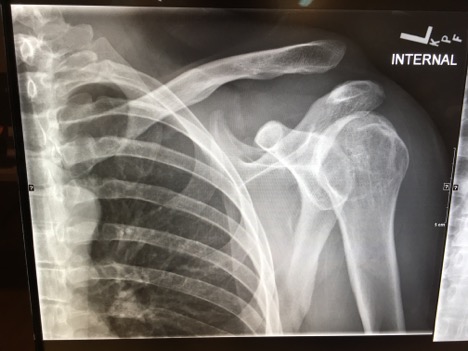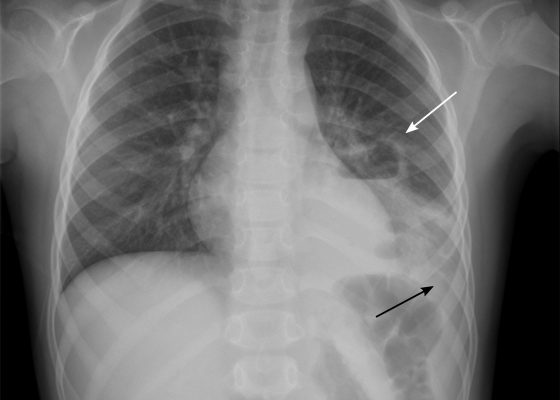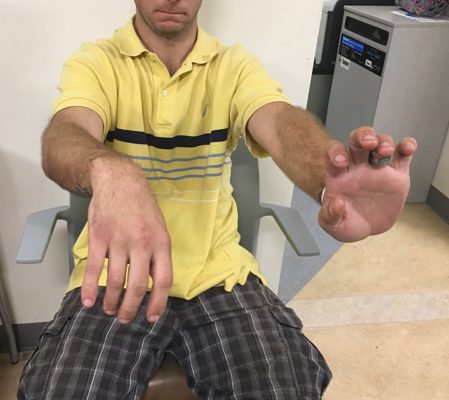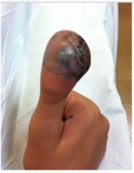Visual EM
Acromioclavicular joint separation
DOI: https://doi.org/10.21980/J8C91GHistory of present illness: A 30-year-old male was brought in by ambulance to the emergency department as a trauma activation after a motorcycle accident. The patient was the helmeted rider of a motorcycle traveling at an unknown speed when he lost control and was thrown off his vehicle. He denied loss of consciousness, nausea, or vomiting. The patient’s vital signs
Torsades de Pointes
DOI: https://doi.org/10.21980/J87K91The patient was found to be in a polymorphic ventricular tachycardia; he was alert, awake and asymptomatic. A rhythm strip showed a wide complex tachycardia with the QRS complex varying in amplitude around the isoelectric line consistent with Torsades de Pointes.
Pediatric Pulmonary Abscess
DOI: https://doi.org/10.21980/J83S6QUpright posterior-anterior plain chest films show a left lower lobe consolidation with an air-fluid level and a single septation consistent with a pulmonary abscess (white arrows). A small left pleural effusion was also present, seen as blunting of the left costophrenic angle and obscuration of the left hemidiaphragm (black arrows).
Scaphoid Fracture
DOI: https://doi.org/10.21980/J80344The anteroposterior (AP) plain film of this patient demonstrates a full thickness fracture through the middle third of the scaphoid (red arrow), with some apparent displacement (yellow lines) and subtle angulation of the fracture fragments (blue line).
Type 1 Brugada Syndrome
DOI: https://doi.org/10.21980/J8V91TECG shows an incomplete right bundle branch block (blue arrow) with coved ST segment elevation and an inverted T wave in V1 (red arrow) and ST segment elevation in V2 (black arrow).
Acute comminuted intertrochanteric hip fracture
DOI: https://doi.org/10.21980/J8QK9CHistory of present illness: A 69-year-old male presented to the emergency department (ED) with left hip pain after he was rear-ended on his bicycle by a vehicle traveling 10-15 miles per hour. He had normal vital signs. On exam, his left lower extremity was externally rotated and shortened with trochanteric point tenderness. His pelvis was stable. His lower extremity compartments
Radial Nerve Palsy
DOI: https://doi.org/10.21980/J8KS7FOn physical exam, the patient was unable to extend his right wrist, thumb, and fingers, and had no sensation of his 1stdorsal interosseous muscles up to the proximal dorsal radial aspect of his forearm. The patient also had slight weakness in thumb abduction. Triceps strength was preserved.
Osborn Waves
DOI: https://doi.org/10.21980/J8G34GThe initial ECG shows a junctional rhythm with Osborn waves (or J point elevations/J waves) in the lateral precordial leads, as well as the limb leads (Image 1). The second ECG, 49 minutes later, shows an improving ventricular rate and Osborn wave height decrease of approximately 50% (Image 2).
Rare Rapidly Growing Thumb Lesion in a 12-Year-Old Male
DOI: https://doi.org/10.21980/J8B92JHistory of present illness: A 12-year-old male presented to the emergency department with right thumb pain and a mass for four months (see images). He denied fevers, chills, change in appetite, or fatigue. He noted that the lesion was growing and “bleeds easily if bumped.” He denied any trauma to the thumb, except “hitting it” months ago while in football
Large Ventral Hernia
DOI: https://doi.org/10.21980/J86K9QComputed tomography (CT) scan with intravenous (IV) contrast of the abdomen and pelvis demonstrated a large pannus containing a ventral hernia with abdominal contents extending below the knees (white circle), elongation of mesenteric vessels to accommodate abdominal contents outside of the abdomen (white arrow) and air fluid levels (white arrow) indicating a small bowel obstruction.










